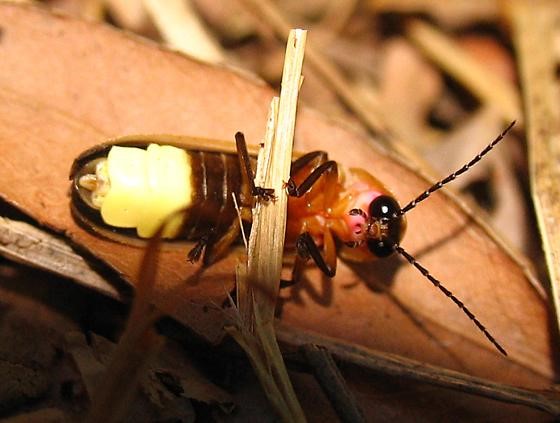By Brandon Brogle and Jack Van Burick

CC Some Rights Reserved Terry Priest
Picture this: it’s a comfortable 75ºF night in the middle of June. You peer out your window and notice brief flashes of light that dance across your lawn, some here, some over there. You go outside to get a closer look. The flashes of light look like they’re flying! You reach out with open arms and intent on grabbing the first light you see. You’ve probably caught a Big Dipper Firefly (Photinus pyralis)! These little guys and girls are the most common type of firefly in eastern North America, so you’ve no doubt seen them on a warm summer night flying and lighting up the night.
Believe it or not, it’s a common misnomer to call this insect “flies” because they are beetles. Big Dippers have two inner wings for flying and two hardened outer wings for protection. They’re about the length of a penny, have long black wings lined with white alongside a large predominantly red head and with small, thin antennae. These beetles get their name from how they fly when they use their light organs during the evening. A male big dipper will fly in a soft “J” shape while lighting up the night and attracting the ladies. This flight pattern is the easiest way to tell the difference between multiple species of firefly! Different species of fireflies have different light patterns, some emit slow flashes every few feet, and some even produce light in a zig-zag.
Males frequently compete with regards to flash duration and intensity to win over the amorous attention of females. When there aren’t a lot of males in the area searching, males spend much less time guarding mates. Oftentimes winners simply out flashed their competitors. Don’t be fooled, though! There are some species of predatory firefly that will actually lure the male Big Dipper into flying close to mate but will actually trap them and eat them (Lured and liquidated, gullible male fireflies supply ‘femmes fatales’ with a lifesaving chemical )! This is because this particular species of firefly has chemicals in its body that helps them to repel spiders. Predatory fireflies don’t produce these chemicals, so they must resort to trickery to obtain them. Big Dipper fireflies use these chemicals when trying to protect themselves from predators. When threatened, the firefly excretes these unpleasant fluids when disturbed because they often smell foul and taste terrible. This process is called reflexive bleeding, and it looks like a ton of other fireflies are capable of the same thing!
One thing you may not have expected is that the increasing amount of light pollution is messing with the mating signals of these fireflies. You don’t even have to be near a big city for this to occur. The light can project into the atmosphere and then be reflected into the wild. Imagine this, you are a male firefly trying to find a nice female to settle down with. You’re flashing away trying to attract someone, anyone, but no females show up. Well, that’s because the females were all running towards the reflected light from the atmosphere and not finding any males. All of this excess light is a real killjoy to both the male and female fireflies. Remember those predatory fireflies from earlier? It even interferes with their method of luring! Light pollution, along with excess use of pesticides, chemical pollution, and habitat loss, is leading to an overall decline of the firefly population (Fireflies Have a Mating Problem: The Lights Are Always On). The possible disappearance of fireflies could lead to many ecological issues, as they are predators of certain pests and pollinators of the food that we eat (Firefly Ecosystem Services).

CC Some Rights Reserved Welcome Wildlife
Fireflies are probably one of the best things about summer. Being able to sit out on your back porch and enjoy miniature fireworks in your backyard is something we can all appreciate. It is a potent visual reminder of the all too short summer season. Whether or not you call them fireflies or lightning bugs, we can all agree that big dipper fireflies are very cool insects.
Wow, I never knew how much light pollution could affect firefly populations. Fireflies really are one of the best parts of summer, so I can only hope that we can keep them around, for ecological reasons and for aesthetic reasons!
I love fireflies in the summer! I was super interested to read this article. I love your inclusion of telling firefly species apart by their flight pattern, because this is a cool thing to look for. I will also look out for different flashing patterns, which are important for their mating season.